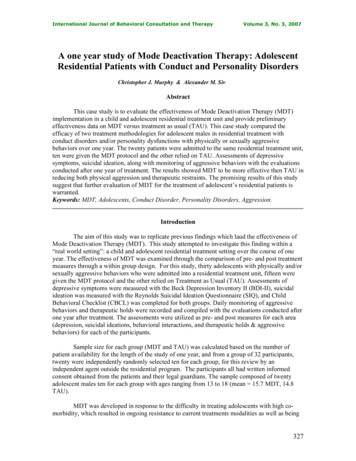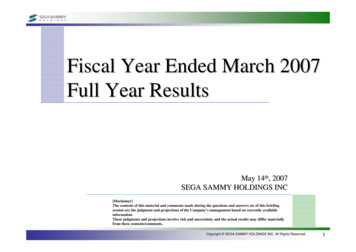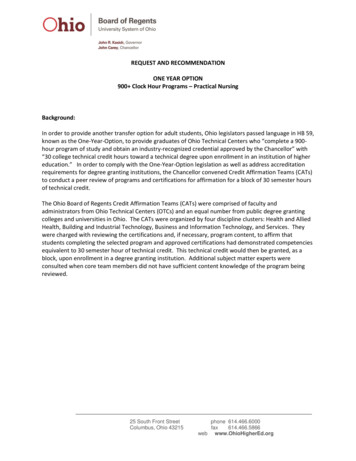
Transcription
International Journal of Behavioral Consultation and TherapyVolume 3, No. 3, 2007A one year study of Mode Deactivation Therapy: AdolescentResidential Patients with Conduct and Personality DisordersChristopher J. Murphy & Alexander M. SivAbstractThis case study is to evaluate the effectiveness of Mode Deactivation Therapy (MDT)implementation in a child and adolescent residential treatment unit and provide preliminaryeffectiveness data on MDT versus treatment as usual (TAU). This case study compared theefficacy of two treatment methodologies for adolescent males in residential treatment withconduct disorders and/or personality dysfunctions with physically or sexually aggressivebehaviors over one year. The twenty patients were admitted to the same residential treatment unit,ten were given the MDT protocol and the other relied on TAU. Assessments of depressivesymptoms, suicidal ideation, along with monitoring of aggressive behaviors with the evaluationsconducted after one year of treatment. The results showed MDT to be more effective then TAU inreducing both physical aggression and therapeutic restraints. The promising results of this studysuggest that further evaluation of MDT for the treatment of adolescent’s residential patients iswarranted.Keywords: MDT, Adolescents, Conduct Disorder, Personality Disorders, Aggression.IntroductionThe aim of this study was to replicate previous findings which laud the effectiveness ofMode Deactivation Therapy (MDT). This study attempted to investigate this finding within a“real world setting”: a child and adolescent residential treatment setting over the course of oneyear. The effectiveness of MDT was examined through the comparison of pre- and post treatmentmeasures through a within group design. For this study, thirty adolescents with physically and/orsexually aggressive behaviors who were admitted into a residential treatment unit, fifteen weregiven the MDT protocol and the other relied on Treatment as Usual (TAU). Assessments ofdepressive symptoms were measured with the Beck Depression Inventory II (BDI-II), suicidalideation was measured with the Reynolds Suicidal Ideation Questionnaire (SIQ), and ChildBehavioral Checklist (CBCL) was completed for both groups. Daily monitoring of aggressivebehaviors and therapeutic holds were recorded and compiled with the evaluations conducted afterone year after treatment. The assessments were utilized as pre- and post measures for each area(depression, suicidal ideations, behavioral interactions, and therapeutic holds & aggressivebehaviors) for each of the participants.Sample size for each group (MDT and TAU) was calculated based on the number ofpatient availability for the length of the study of one year, and from a group of 32 participants,twenty were independently randomly selected ten for each group, for this review by anindependent agent outside the residential program. The participants all had written informedconsent obtained from the patients and their legal guardians. The sample composed of twentyadolescent males ten for each group with ages ranging from 13 to 18 (mean 15.7 MDT, 14.8TAU).MDT was developed in response to the difficulty in treating adolescents with high comorbidity, which resulted in ongoing resistance to current treatments modalities as well as being327
International Journal of Behavioral Consultation and TherapyVolume 3, No. 3, 2007considered treatment failures in both the outpatient and residential settings. Apsche et al (2004)have demonstrated that MDT is effective in reducing aggression and suicidal ideations within thispopulation. Apsche began to formulate MDT as a response to the need for a more efficacioustreatment for this specific adolescent typology. Through the synthesizing of an applied CBTmethodology as well as Linehan’s work with Dialectical Behavior Therapy (DBT) MDT wasdeveloped for adolescents who displayed a reactive conduct disorder, personality disorders/ traits,and Post Traumatic Stress Disorder symptomology. Apsche and his colleagues havedemonstrated the effectiveness of MDT in reducing aggression, specifically with adolescents whodisplay the aforementioned diagnostic traits (Apsche, Bass, Murphy 2004; Apsche & Ward2004). Apsche & Siv (2005) further emphasize the need for an efficacious methodology bypositing the development of personality disorder traits/features as a coping mechanism by theseadolescents. This methodology encapsulates the needs of these adolescents who present with acomplicated neglect, multi-axial diagnoses, as well as often being the victims of sexual, physical,and/ or emotional abuse.MDT also includes a series of mindfulness exercises that are specifically designed forthese adolescents. Exercises incorporated within the client workbook designed to allow the youthto practice the technique which helps ensure trust, reduce anxiety and increase commitment totreatment as it helps develop mindfulness skills for the youth. The mindfulness skills result indevelopment of the youths heightened awareness of their fears, triggers and beliefs which helps,them to use this new coping strategies in place of the aggressive behaviors.Several descriptive studies indicate that MDT has been more effective than standardizedCBT in the treatment of this population of adolescents (Apsche & Ward, 2002). MDT has alsobeen demonstrated as effective in a series of case studies (Apsche, Ward, Evile, 2002 a & b;Apsche & Ward Bailey, 2003) and an empirical study which shows that it was more effectivethen standard CBT and Social skills training (Apsche, Bass, Siv, 2005). Preliminary results ofseveral recent case studies has shown MDT to be effective in reducing suicidal ideation and inreducing fire setting behaviors (Apsche & Siv, 2005, Apsche, Siv, Bass, 2005). The study of thismethodology is important on several levels. The first level being the need to provide evidencebased therapy for adolescents with deficits in multiple areas regarding their mental health issues.Kazdin and Weisz (2003) indicate how aggressive behaviors have an adverse effect not only onthe adolescent but also in a variety of social settings such as academics, peer relations, and anincreased contact with the juvenile justice system. Providing a methodology which allowsincreased progress with this difficult population as well as offering hope to both providers andclients is paramount for the benefit of both parties.MethodParticipantsThe sample comprised of 20 male adolescents residential patients who participated in thestudy. All subjects were referred to the same residential treatment facility for the treatment ofaggression. In this study, subjects were randomly assigned to one of the two treatment conditionsat the time of admission based on available openings in the caseload of the participatingclinicians. The two treatment conditions showed similarity in terms of the frequency of Axis Iand Axis II diagnoses, age, and racial background. To ensure consistency in the delivery of thetwo respective treatments, therapists were specifically trained in the one of the three treatmentcurriculums/methods. The average length of residential treatment across all conditions was oneyear.328
International Journal of Behavioral Consultation and TherapyVolume 3, No. 3, 2007Treatment As Usual (TAU): A total of ten male adolescents were assigned to the TAUcondition. The group was comprised of 4 African Americans, 4 European Americans and 2Hispanic American with an average age of 14.8. The principal Axis I diagnoses for this groupincluded Conduct Disorder (4), Oppositional Defiant Disorder (4), and Post Traumatic StressDisorder (7). Axis II diagnoses for the group included Mixed Personality Disorder (4),Borderline Personality Disorder (2), Narcissistic Personality Disorder (1) and DependentPersonality Disorder (1).TAU consisted of a daily psychodynamic psychotherapy group, individualpsychodynamic psychotherapy at least once per week, Psychoeducational oriented milieu basedon The Boys and Girls Town’s Psychoeducational Model. Components of this psychoeducationaltreatment curriculum included daily recording teaching social skills on point card sheets. Allclinicians are trained in adolescent psychodynamic, the TAU team met regularly for to discusstreatment concerns.Mode Deactivation Therapy (MDT): A total of ten male adolescents were assigned to theMDT condition. The group was comprised of 5 African Americans, 3 European Americans and 2Hispanic American with an average age of 15.7. The principal Axis I diagnoses for this groupincluded Conduct Disorder (5), Oppositional Defiant Disorder (3), Post Traumatic StressDisorder (7), and Major Depressive Disorder, primary or secondary (2). Axis II diagnoses for thegroup included Mixed Personality Disorder (6), Borderline Personality Traits (3), and NarcissisticPersonality Traits (2). The MDT condition used the methodology described earlier in this paper.Table 1. Composition of both treatment groupsAxis IConduct DisorderOppositional Defiant DisorderPost Traumatic Stress DisorderMajor DepressionAxis IIMixed Personality DisorderBorderline Personality TraitsNarcissistic Personality TraitsDependent Personality TraitsAvoidant Personality TraitsRaceAfrican AmericanEuropean AmericanHispanic/Latino AmericanTotalAverage AgeTAU4470MDT53724221063200442105321014.815.7329
International Journal of Behavioral Consultation and TherapyVolume 3, No. 3, 2007InstrumentsPretreatment and Posttreatment assessments involved a battery of self-report measurestargeting multiple risk factors. The baseline (“pre-treatment”) measure of physical aggressionconsisted of the average number of incidents that occurred during the first 60 days followingadmission and the post-treatment measure was the rate of occurrence during the 60 day periodprior to discharge. In addition, a key measures of physical aggression used in this study consistedof Daily Behavior Reports and Behavior Incident Reports. The Daily Behavior Reports andBehavior Incident Reports were completed by all levels of staff, both professional andparaprofessional, across all settings of the residential treatment program (e.g., schoolroom,psychoeducational classes, treatment activities, residential dormitories, etc.). The BehaviorIncident Reports were only completed by staff following the occurrence of serious or criticalincidents, namely, acts of physical aggression and/ or therapeutic holds. Inter-rater reliability inthe use of the measures was determined by independently totaling the number of physicalaggression incidents on both the Daily Behavior Report cards and the Behavior Incident Reportforms and calculating the percentage of agreement. The agreement for this study was at the 93%level.The self-report measures consisted of the following assessments which were used tomeasure the residents pretreatment and posttreatment, which included the Child BehaviorChecklist (CBCL; Achenbach, 1991, 2001). The CBCL is a multiaxial assessment designed toobtain reports regarding the behaviors and competencies of 6 – to – 18 year olds. The means andstandards are divided into three categories: internalizing (which measures withdrawn behaviors,somatic complaints, anxiety and depression), externalizing (which measures delinquent behaviorand aggressive behavior), and total problems (which represent the conglomerate of total problemsand symptoms, both internal and external). Beck Depression Inventory (BDI) (Beck and Beck,1972; Beck et al., 1961) which is designed to measure depression, and the Reynolds’ SuicidalIdeation Questionnaire (SIQ) (Reynolds, 1988) to assess the change in suicidal ideation pre andposttreament. Subjects completed these measures at admission and at discharge.Following completion of one year of treatment, the number of incidents reports filed bythe staff was calculated for both MDT and TAU groups.TABLE 2. Descriptive Statistics of Measures for MDT and TAU Groups For Baselineand Post-treatment Results.Descriptive 30
International Journal of Behavioral Consultation and calAggressionPost-TreatmentTherapeuticHoldsVolume 3, No. 3, 63.42.118.09910123Total203.722.36.10807.5Thus, this first analysis shows that all types of treatment – Mode Deactivation Therapyand Treatment as Usual – had a positive effect of reducing rates of physical aggression andtherapeutic holds over the course of treatment (see Figure 1).Reduction in Rates of Physical Aggression andTherapeutic Holds10987Baseline Therapeutic Holds65Post-Treatment Therapeutic Holds4Baseline Physical Aggression3Post-Treatment Physical Aggression210MDTTAUFigure 1. Reduction in Rates of Physical Aggression and Therapeutic Holds of MDT ModeDeactivation Therapy Compared to TAU Treatment as Usual Groups.To better elucidate the differences between groups in magnitude of effect, independentfactorial analyses on treatment model and variable were conducted.331
International Journal of Behavioral Consultation and TherapyVolume 3, No. 3, 2007With an overall percent reduction of 70.7% in rates of post-treatment therapeutic holds,Mode Deactivation Therapy was found to be superior to the Treatment As Usual which had a24.7% reduction rate. The most dramatic difference between treatment groups was found inreduction of post-treatment rates of physical aggression and therapeutic holds. In this instance,Mode Deactivation Therapy showed a statistically significant reduction in rates of physicalaggression from baseline to post-treatment. MDT showed a reduction of 66.8% in Physicalaggression compared to TAU at 27.9%. Post-treatment rates of physical aggression were 2.7(incidents per month) for MDT and 6.9 (incidents per month) for TAU. The results clearly showthat MDT produced significantly superior results when compared to TAU. These differences inmagnitude of effect are graphically represented in Figure 2.TABLE 3. Comparison of Post-Treatment Incident Avg. of Holds and AggressiveIncidents for Both Treatment Groups.MDTTAUPost-TreatmentMonthly Avg.PercentreductionPost-TreatmentMonthly Avg.Percent reductionPhysical Aggression2.766.7%6.927.9%Therapeutic Holds2.170.7%5.324.7%Post-Treatment Avg. for Holds and Aggression Across TwoTreatment Conditions8Number of 5.36.9Figure 2. Post-Treatment Reduction Rates for Aggression and Therapeutic Holds for MDTand TAU Treatment Groups332
International Journal of Behavioral Consultation and TherapyVolume 3, No. 3, 2007The CBCL is a multiaxial assessment designed to obtain reports regarding the behaviorsand competencies of 6 – to – 18 year olds. The means and standards are divided into threecategories: internalizing (which measures withdrawn behaviors, somatic complaints, anxiety anddepression), externalizing (which measures delinquent behavior and aggressive behavior), andtotal problems (which represent the conglomerate of total problems and symptoms, both internaland external).TABLE 4. CBCL Scores, Ranges, and Standard Deviations for Baseline and Post-TreatmentMeasures for Both Treatment GroupsMeasureScaleTAUMDTChild BehaviorChecklist (CBCL)Pre-TreatmentInternal71.43 (Range 66 - 84)74.57 (Range 68 - 86)External73.74 (Range 66 - 86)74.94 (Range 64 - 86)Total72.6774.74Internal63.66 (Range 55 - 80)SD 10.0465.63 (Range 52 - 82)SD 10.7664 (Range 52 – 84)SD 9.2451.75 (Range 39 - 71)SD 12.1050.04 (Range 37 - 69)SD 11.7451.00 (Range 40 – 61)SD 10.28Child BehaviorChecklist (CBCL)Post-TreatmentExternalTotalMDT’s mean CBCL scores are at least one standard deviation less then the TAU meanscores. Even with the CBCL assessment the two groups differed significantly. Residents whoparticipated in MDT had lower scores on all measures then did residents who engaged in TAU.The results indicate that the mean scores the internalizing factor, externalizing factor, andtotal scores for the MDT group is at or near one standard deviation below the TAU group.333
International Journal of Behavioral Consultation and TherapyVolume 3, No. 3, 2007Mean CBCL Scores for MDT and TAU Groups Pre alMDT74.5774.9474.74TAU71.4373.7472.67Figure 3. Mean CBCL Scores for MDT and TAU Groups Pre-TreatmentMean CBCL Scores for MDT and TAU Groups lTotalMDT51.7550.0451TAU63.6665.6364Figure 4. Mean CBCL (Child Behavioral Checklist) Scores for MDT (ModeDeactivation Therapy, and TAU (Treatment as Usual) Post-Treatment334
International Journal of Behavioral Consultation and TherapyVolume 3, No. 3, 2007Beck Depression Inventory (BDI) (Beck and Beck, 1972; Beck et al., 1961) which isdesigned to measure depression, and the Reynolds’ Suicidal Ideation Questionnaire (SIQ)(Reynolds, 1988) to assess the change in suicidal ideation pre and post-treatment. Subjectscompleted these measures at three time points results shown in Table 4 and Table 5 and the meanscores shown graphically in figures 5 and 6.TABLE 4. Means and Standard Deviations on Assessment Measures at Three Time Points ByTreatment GroupsMDTTAUBaseline3 Months6 MonthsBaseline3 Months6 MonthsMSDMSDMSDMSDMSDMSD34.2 14.65 14.6 9.54BDI-II9.9 6.18 26.8 20.62 17.5 14.37 12.7 12.91SIQHS57.2 29.29 10.9 14.43 7.2 7.37 55.4 49.34 18.6 18.90 12.9 13.66Note: All baseline comparisons between groups were non-significant (p .05)BDI-II Beck Depression Inventory 2nd Edition; SIQ-HS Suicidal Ideation Questionnaire HighSchool Form; MDT Mode Deactivation Therapy; TAU Treatment as usual.TABLE 5. Means, Standard Deviation, Max and Min for Assessment Measure at Three TimePoints by Treatment GroupsBDI-IISIQ-HSN Min Max MeanSDMin Max MeanSDMDTBaseline 10 293934.214.65476657.2 29.69TAUBaseline 10 193126.820.62476455.4 310102217.514.3763219.618.906Months 109119.96.180127.27.376Months 10TAU81612.712.9152212.9 13.66Note: All baseline comparisons between groups were non-significant (p .05)BDI-II Beck Depression Inventory 2nd Edition; SIQ-HS Suicidal Ideation Questionnaire HighSchool Form; MDT Mode Deactivation Therapy; TAU Treatment as usualMDT335
International Journal of Behavioral Consultation and TherapyVolume 3, No. 3, 2007BDI-II Scores for MDT and TAU Groups4035Avg. BDI-II Scores3025MDTTAU20151050Baseline3 Months6 MonthsFigure 5: Means scores for BDI- II at three time points. Note: All baseline comparisons betweengroups were non-significant (p .05) BDI-II Beck Depression Inventory 2nd Edition; MDT Mode Deactivation Therapy; TAU Treatment as usualReynolds Scores for MDT and TAU Groups7060Avg. SIQ-HS Scores5040MDTTAU3020100Baseline3 Months6 MonthsFigure 6: Mean Scores for SIQ-HS at three time points. Note: All baseline comparisons betweengroups were non-significant (p .05) SIQ-HS Suicidal Ideation Questionnaire High SchoolForm; MDT Mode Deactivation Therapy; TAU Treatment as usual336
International Journal of Behavioral Consultation and TherapyVolume 3, No. 3, 2007Baseline Monthly Avg. for MDT and TAU TreatmentConditions109Number of Incidents876543210HoldsPhysical AggressionMDT7.13047.9565TAU7.04349.5217Figure 7. Baseline Avg. of Physical Aggression and Therapeutic Holds for MDT vs. TAUPost-Treatment Avg for MDT and TAU Treatment Conditions10Number of Incidents9876543210HoldsPhysical AggressionMDT2.08692.6521TAU7.04348.8695Figure 8. Post-Treatment Avg. for Physical Aggression and Therapeutic Holds for MDT vs.TAU337
International Journal of Behavioral Consultation and TherapyVolume 3, No. 3, 2007ResultsThis study was initiated to compare the efficacy of Mode Deactivation Therapy (MDT) tothe current treatment as usual (TAU) in the treatment of aggressive adolescent males inresidential treatment. The analysis of the Daily Behavioral reports, which indicated a number ofobserved aggressive acts, were compiled, statistical analysis of the results ensued. It was foundthat all participants benefited from treatment regardless of theoretical orientation (see Figure 1).The baseline average rate of aggression across all groups was 8.73 with a total standarddeviation of 2.31 and standard error of .116. The MDT group had a 66.7% reduction in rate ofaggression, with a posttreatment mean of 2.65, with a standard deviation of 2.36 and standarderror of .105. Added to the results performed on the difference between baseline andposttreatment rates of therapeutic holds. The baseline mean across both groups was 7.09 with atotal standard deviation of .115 and standard error of .109. The MDT group had a 70.7%reduction in the rate of therapeutic holds to the post-treatment mean of 2.09 with a standarddeviation of 3.42 and standard error of .099.On the CBCL both TAU and MDT reduced both internal and external scores. MDTscores on 1 SD or more significance then the TAU scores. With MDT’s CBCL t-scores reducingfrom 74.74 pretreatment to 51.00 posttreatment which is a 31.7 % reduction, compared to TAU’sCBCL posttreatment percent reduction at 11.9%. These results suggest that MDT is effective inreducing symptoms of Axis I pathology.On the BDI-II both TAU and MDT performed well in measures of the difference betweenbaseline and post-treatment rates of depression. The baseline mean BDI-II scores of 26.8 TAUand 34.2 MDT, and post-treatment scores of 12.7 and 9.9, with standard deviation of 6.18 and12.91 respectfully. These suggest that MDT is effective in reducing symptoms of Depression.On the SIQ both TAU and MDT performed well in measures of the difference betweenbaseline and post-treatment rates of depression and suicidal ideation. The baseline mean SIQscores of 55.4 TAU and 57.2 MDT, and post-treatment scores of 12.97 and 7.20 and standarddeviations of 13.66 and 7.93 respectfully. These suggest that MDT is effective in reducingsymptoms of depression and suicidal ideation.DISCUSSIONThe data indicates that Mode Deactivation Therapy (MDT) may achieve superior resultsin reducing both physical aggression and therapeutic holds, in conduct-disordered andpersonality-disordered youth in a long-term residential treatment setting. Moreover, while bothtreatments were effective in reducing physical aggression, only (MDT) demonstrated a significantreduction in rates of therapeutic holds. These finding also suggests supports earlier studies thatMDT could be an effective treatment for reducing depression and suicidal ideation from BDI andSIQ results.As in any real world study, it is always difficult to control for the levels of competence ofthe participating therapists and their adherence to the “purity” of both treatment methods. Bestefforts were made to control for this common problem by ensuring that therapists shared the sameprofessional degree and level of clinical experience in each of the two methodologies and byproviding training in the delivery of each model prior to the study. Training and supervision wasprovided by a doctorate level psychologist in both groups. The MDT group was trained by the338
International Journal of Behavioral Consultation and TherapyVolume 3, No. 3, 2007developer of MDT, in order to reduce confounds that may have been produced by additionaltrainers.The strength of the outcomes could be further enhanced with the inclusion of additionaloutcome measures and, ideally, long-term follow-up of the youth who participated in the study.This study measured levels of psychological distress, including internal and external, as measuredby the CBCL, depression with the BDI, and suicide ideation with the SIQ. MDT demonstrated asignificant decrease in all levels of behavior and psychological distress.It is important to note that the authors do not purport that MDT will generalize to anygroups other than adolescents with conduct and personality disorders.The authors hope that future research may use randomized trials in residential, impatienthospital, and outpatient clinics with an attempt to replicate these findings in other residentialtreatment facilities and with other relevant adult and adolescent populations, particularly withthose identified with severe aberrant behaviors including personality disorders, conduct disorderand aggression.ReferencesAchenbach, T.M. (1991). Manual for the Child Behavior Checklist and 1991 profile. Burlington, VT:University of Vermont Department of Psychiatry.Achenbach, T.M. (1991). Child Behavior Checklist, Assessment. Burlington, VT: University of VermontDepartment of Psychiatry.Alford, B.A. and Beck, A.T. (1997). The integrative power of cognitive therapy. New York: GuilfordPress.Apsche, J.A. (2005). Beck’s theory of modes. International Journal of Behavioral Consultation andTherapy, 1(1), pp. 27-45.Apsche, J.A., Bass, C.K., Jennings, J.L., Siv, A.M. (2005). International Journal of Behavior Consultationand Therapy, 1(1), pp. 27-25.Apsche, J.A., Bass, C.K., Jennings, J.L., Murphy, C.J., Hunter, L.A. (2005). Submitted to: Sexual Abuse:The International Journal of Behavior Consultation and Therapy. Accepted with revisions.Apsche, J.A., Bass, C.K., Jennings, J.L., Murphy, C.J., Hunter, L.A., Siv, A.M. (2005). Submitted to:International Journal of Behavior Consultation and Therapy, Accepted with revisions.Apsche, J.A., Bass, C.K., Murphy, C.J., (2004). A comparison of the effectiveness of Mode deactivationtherapy, Cognitive behavior therapy in adolescents with conduct disorders. : The Journal ofBehavior Analyst Today. Vol.5. No. 4. Winter 2004.Apsche, J.A., Bass, C.K., Siv, A.M. (2005). Submitted to: International Journal of Behavior Consultationand Therapy. Accepted with revisions.Apsche, J.A. (1999). Thought Change Workbook. Portsmouth, VA: Alternative Behavioral services.Apsche, J.A., Evile, M.M., and Murphy, C.J. (2004). The thought change system: An empirically basedcognitive behavior therapy for male juvenile sex offenders. A pilot study. Thef Behavior AnalysisToday, 5(1), 101-107.339
International Journal of Behavioral Consultation and TherapyVolume 3, No. 3, 2007Apsche, J.A. and Ward Bailey, S.R. (2004a). Mode Deactivation Therapy: Cognitive-behavioural therapyfor young people with reactive conduct disorders or personality disorders or traits who sexuallyabuse. In M.C. Calder (Ed.), Children and Young People who Sexually Abuse: New Theory,Research and Practice Developments, pp. 263-287. Lyme Regis, UK: Russell House Publishing.Apsche, J.A. and Ward Bailey, S.R. (2003). Mode deactivation therapy: A theoretical case analysis (PartI). The Behavior Analyst Today, 4(3), 342-353.Apsche, J.A. and Ward Bailey, S.R. (2004b). Mode deactivation therapy: A theoretical case analysis (PartII). The Behavior Analyst Today, 5(1), 395-434.Apsche, J.A. and Ward Bailey, S.R. (2004c). Mode deactivation therapy: A theoretical case analysis (PartIII). The Behavior Analyst Today, 5(3), 314-332.Beck, A.T. (1996). Beyond belief: A theory of modes, personality and psychopathology. In P.M.Salkovaskis (Ed.), Frontiers of cognitive therapy, (pp. 1-25). New York: Guilford Press.Beck, A.T., Beck R.W. (1972). Screening depressed patients in family practice: a rapid technique. PostgradMed 52: 81-85Beck, A.T. and Freeman, A. (1990). Cognitive therapy of personality disorders. New York: GuilfordPress.Beck, A.T., Freeman, A., Davis, D.D. and Associates. (1994). Cognitive Therapy of Personality Disorders.New York, Guilford Press.Beck, A.T., Freeman, A., Davis, D.D. and Associates. (2004). Cognitive Therapy of Personality Disorders.New York, Guilford Press.Beck, A.T., Ward C., Mendelson M., Mock J., Erbaugh J. (1961). An Inventory for measuring depression.Arch Gen Psych 4: 53-63Boesky, L.M. (2002). Juvenile offenders with mental health disorders: Who are they and what do we dowith them? Lanham, MD: American Correctional Association.Dodge, K.A., Lochman, J.E., Harnish, J.D., Petti, G.S. (1997). Reactive and proactive aggression inschool children and psychiatrically impaired chronically assaultive youth. Journal of AbnormalPsychology, 106 (1), 37-51.Freeman, A., Pretzer, J., Fleming, B., and Simon, K.M. (1990). Clinical applications of cognitive therapy.New York: Plenum.Henggeler, S.W., Schoenwald, S.K., Borduin, C.M., Rowland, M.D. and Cunningham, P.B. (1998).Multisystemic treatment of antisocial behavior in children and adolescents. New York: GuilfordPress.Johnson, J.G., Cohen, P., Brown, J., Smailes, E.M., and Bernstein, D.P. (1999). Associations between fourtypes of childhood neglect and personality disorder symptoms during adolescence and earlyadulthood: Findings of a community-based longitudinal study. Archives of General Psychiatry,14, 171-120.Kazdin, A.E. and Weisz, J.R. (2003). Evidenced-based psychotherapies for children and adolescents.New York: Guilford Press.Koenigsberg, H.W., Harvey, P.D., Mitropoulou, V., Antonia, N.S., Goodman, M., Silverman, J., Serby, M.,Schopick, F. and Siever, L. (2001). Are the interpersonal and identity disturbances in the340
International Journal of Behavioral Consultation and TherapyVolume 3, No. 3, 2007borderline personality disorder criteria linked to the traits of affective instability and impulsivity?Journal of Personality, 15(4), 358-370.Kohlenberg, R.J. and Tsai, M. (1993). Functional Analytic Psychotherapy: A behavioral approach tointensive treatment. In W. O’Donahue and L. Krasner (Ed)., Theories of behavior therapy:Exploring behavior change (pp. 638-640). Washington, D.C.: American PsychologicalAssociation.Links, P.S., Gould, B., Ratnayake, R. Assessing suicidal youth with antisocial, borderline, or narcissisticpersonality disorder. The Canadian Journal of Psychiatry. June 2003.Linehan, M.M. (1993). Treating Borderline Personality disorder: The dialectical approach. New York:Guilfor
MDT also includes a series of mindfulness exercises that are specifically designed for these adolescents. Exercises incorporated within the client workbook designed to allow the youth to practice the technique which helps ensure trust, reduce anxiety and increase commitment to . Borderline Personality Disorder











